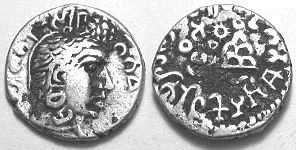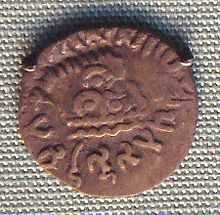Gautamiputra Satakarni
| Gautamiputra Satakarni | |
|---|---|
| Satavahana | |
| Reign | 78–102 CE |
| Titles | Satvahanakulajashapratisthankar |
| Wife | According to Dr. Dineshchandra Sarkar the entire land in the south of Bindhya parvat was Goutamiputra Satkarani's kingdom. |
| Mother | Gautami Balashree |



Gautamiputra Satakarni (Telugu: గౌతమిపుత్ర శాతకర్ణి (gautamiputra śatakarṇi); Marathi: गौतमीपुत्र सातकर्णि (gautamīputra śatakarṇi); also known as Shalivahana) (c. 78–102 CE) was the twenty-third ruler of the Satavahana Empire.
Rule
We know about him from an inscription composed by his mother, Gautami Balashri. Gautamiputra Satakarni, often acknowledged by historians as the greatest of the Satavahana rulers, took to the throne after his father, Satakarni. Satakarni had earlier expanded the Satavahana Empire and gained considerable prosperity due to his two Ashwamedha sacrifices. When Gautamiputra ascended the throne, the Satavahana Empire was loosely attached and was facing the threats of foreign invasions from Sakas and Yavanas. Gautamiputra defeated the Yavanas, Sakas, and Pahlavas and re-established the ancient glory of the Satavahanas. The Shaka rulers Nahapana and Ushavadata were ultimately defeated by the powerful Satavahana king Gautamiputra Satakarni. Gautamiputra drove the Sakas from Malwa and Western Maharashtra, forcing Nahapana west to Gujarat. Gautamiputra restruck many of Nahapana's coins. He overthrew Nahapana and restruck a large number of Ksaharata coins of the Jogalthembi hoard.[1]
The Nasik Prasasti describes Gautamiputra as the ruler of the Aparanta, Anupa, Saurashtra, Kukura, Akara, and Avanti, and he must have wrested them from Nahapana. He also seems to have recovered the territories in Central Deccan, which had been lost by the Satavahanas during the earlier rule of his predecessors. Under him, the Satavahana arms must have reached as far south as Kanchi. He is also credited with the conquest of territories in the Kolhapur area in the Southern Maharashtra, which he seized from the Ananda rulers. Gautamiputra also annexed the Banavasi area, thus established his sway over portions of Karnataka. After conquering Malwa from a Saka ruler, Gautamiputra Satakarni issued local type of coins, particularly in Malwa for convenience of the people.[2] On the obverse, there is the figure of an elephant with its trunk and on the reverse, the peculiar device of Ujjain symbol.[3] This latter, not known on any Satavahana coins. It was prevalent only on the coins of Malwa.[4] He was succeeded by his son, Vasisthiputra Sri Pulamavi.
Satakarni started the Shalivahana era or Shaka Calendar which is still used by Gujaratis, Marathas, Telugus, Kannadigas and Konkanis. [citation needed]
Etymology of the Name
Gautamiputra Satakarni bears a name which has made some historians entertain a theory regarding matriarchy among the Satavahanas. He is called Gautamiputra even as there is another ruler called Vasishtiputra Sri Pulumayi and yet another Kausikiputra Satakarni and these mean Satakarni son of Gautami, Sri Pulumayi son of Vasishti and Satakarni son of Kausiki and in these cases Gautami, Vasishti and Kausiki were the names of the mothers of these rulers respectively.
That they prefix their mother's names to theirs seems to mean to these historians that they derive themselves in the female line and not in the male line thereby suggesting matriarchy. This is not acceptable for there is no other evidence to support such a radical conclusion and even in Kerala matriarchy came in much later, certainly not before a few centuries after the Sangam age.
The real explanation for this kind of matronymic seems to be that since the rulers married a number of wives from different royal families a prince was best identified with reference to his mother. This practice is found reflected in the system adopted in the colophons to the Padirruppattu a Tamil Sangam anthology in which early Chera genealogy is mentioned. Gautamiputra was very charitable and there is a record which mentions his gift of a piece of land which had originally belonged to one Ushavadatta. Vasishtiputra Sri Pulumayi (AD 130-158)[5]
Gautamiputra Satakarni took the titles of:
- Trisamudrapitatoyavahana (one whose horses had drunk waters from 3 oceans)
- Sakayavanapallavanisudana (destroyer of Saka, Yavana and Pahlavas)
Notes
- ↑ Some early dynasties of South India by S. Chattopadhyaya
- ↑ Malwa Through the Ages, from the Earliest Times to 1305 A.D by Kailash Chand Jain: p.168
- ↑ Malwa Through the Ages, from the Earliest Times to 1305 A.D by Kailash Chand Jain: p.168
- ↑ Malwa Through the Ages, from the Earliest Times to 1305 A.D by Kailash Chand Jain: p.168
- ↑ Short Notes on Gautamiputra Satakarni
| Preceded by Sivasvati |
Satavahana ruler 78–102 CE |
Succeeded by Vasisthiputra Sri Pulamavi |